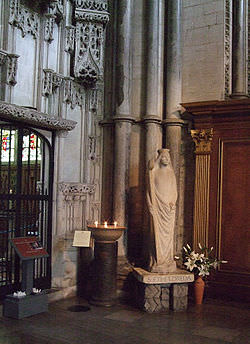Romanos the Melodist and the Christian self in early Byzantium
Romanos the Melodist and the Christian self in early Byzantium By Derek Krueger Paper given at the 21st International Congress of Byzantine Studies (2006)…
Monstrous Conversions: Recovering the Sacramental Bodies of The Passion of St. Christopher
This article examines the monstrous attributes of the dog-headed St. Christopher and his struggle to convert the pagan king Dagnus in the Old English Passion of St. Christopher.
The Cult of St. Ólafr in the Eleventh Century and Kievan Rus’
The Cult of St. Ólafr in the Eleventh Century and Kievan Rus’ By Haki Antonsson Middelalderforum, Vol.1:2 (2003) Introduction: The sources relating to…
Early medieval hagiography as a source for the history of ideas: attitudes to dreams as an example
Early medieval hagiography as a source for the history of ideas: attitudes to dreams as an example Keskiaho, Jesse (University of Helsinki) MIRATOR 1…
Margery Kempe: Madwoman or Mystic – A Narrative Approach to the Representation of Madness and Mysticism in Medieval England
In this paper, I want to examine this contested boundary by discussing my analysis of a medieval woman’s experience of both madness and mysticism.
The festival of Brigit the Holy Woman
The festival of Brigit the Holy Woman By Séamas Ó Catháin Celtica Vol. 23 (1999) Introduction: In her monumental The Festival of Lughnasa,…
THE LIFE OF ST RUADÁN AND THE CURSING OF TARA
THE LIFE OF ST RUADÁN AND THE CURSING OF TARA Szacillo, Judyta (Queen’s University of Belfast, Northern Ireland) Quest, Issue 6, Spring (2009)…
Music in Honor of the Virgin Mary during the Middle Ages and Renaissance.
The purpose of this study was, first, to explore the basic elements of Marian devotion, and, second, to examine how veneration of Mary was expressed musically.
ST EDMUND OF EAST ANGLIA AND HIS MIRACLES THROUGH THE CENTURIES: VARIATIONS IN LITERATURE AND ART.
ST EDMUND OF EAST ANGLIA AND HIS MIRACLES THROUGH THE CENTURIES: VARIATIONS IN LITERATURE AND ART Fornasini, Ilaria (University of Verona, Italy) Quest, Issue…
TRANSLATION ACCOUNTS AND REPRESENTATIONS OF POPULAR BELIEF IN THE HAGIOGRAPHY OF THE COMMUNITY OF ST FILIBERT
TRANSLATION ACCOUNTS AND REPRESENTATIONS OF POPULAR BELIEF IN THE HAGIOGRAPHY OF THE COMMUNITY OF ST FILIBERT Harding, Christian (University of St Andrews, Scotland)…
New developments in hagiography: the rediscovery of Byzantine hagiography
New developments in hagiography: the rediscovery of Byzantine hagiography By Stephanos Efthymiadis Paper given at 21st International Congress of Byzantine Studies (2006) Introduction:…
Virginity and Chastity for Women in Late Antiquity, Anglo-Saxon England, and Late Medieval England: On the Continuity of Ideas
This essay explores the continuity of ideas regarding virginity and chastity from Late Antiquity through late Medieval times in England
Violence Against Women in Medieval Martyr Legends
Violence Against Women in Medieval Martyr Legends By María Beatriz Hernández Pérez Paper given at the 8th Global Conference: Violence and the Contexts…
“I am the Creator”: Birgitta of Sweden’s Feminine Divine
“I am the Creator”: Birgitta of Sweden’s Feminine Divine Bruce, Yvonne Comitatus: A Journal of Medieval and Renaissance Studies, 32(1) (2001) Abstract Critical…
The cult of St Nicholas in medieval Italy
The cult of St Nicholas in medieval Italy By Sarah Burnett PhD Dissertation, University of Warwick, 2009 Abstract: St Nicholas was one of…
Constructing the past in eleventh-century Flanders: Hagiography at Saint-Winnoc
Constructing the past in eleventh-century Flanders: Hagiography at Saint-Winnoc By David J. Defries PhD Dissertation, Ohio State University, 2004 Abstract: At the heart…
Alfonso X, St. James, and the Virgin
Alfonso X, St. James, and the Virgin By Anthony J. Cárdenas-Rotunno Latin American Institute, Research Paper Series No. 50 (2009) Abstract: This study…
Session 5: Texts, Rituals and the Social Order – Lantfred’s Swithun and the Fundamentals of Reform: Educating Lay Pilgrims in 10th century Winchester
Lantfred’s Swithun and the Fundamentals of Reform: Educating Lay Pilgrims in 10th century Winchester Christopher Reidel (Boston College) Summary At the height of…
A lesson in holy kingship: the thirteenth-century “La estoire de Seint Aedward le Rei”
A lesson in holy kingship: the thirteenth-century “La estoire de Seint Aedward le Rei” By Judtih Collard South African Journal of Art History,…
Session 3: Hostages & Captive Taking in the High Middle Ages Heroes, Fosterage and Hagiography: The Function of Fosterage in Medieval Irish Literature
Heroes, Fosterage and Hagiography: The Function of Fosterage in Medieval Irish Literature Lahney Preston-Matto (Adelphi University) Summary This paper examined the fosterage from…
The Liber miraculorum of Simon de Montfort: Contested sanctity and contesting authority in late thirteenth-century England
The Liber miraculorum of Simon de Montfort: Contested sanctity and contesting authority in late thirteenth-century England By John E. St.Lawrence PhD Dissertation, University of…
Haskins Society Conference – Session 2: Historiography in the Salian Age
Haskins Society Conference – Session 2: Historiography in the Salian Age Fruitolf Michelsberg’s Chronicle, the Schools of Bamberg and the Preservation of Imperial…
Historical and Symbolic Meanings of Body and Gesture in Medieval Miracles, c. 1000- 1200
Historical and Symbolic Meanings of Body and Gesture in Medieval Miracles, c. 1000- 1200 By Uta Kleine Paper given at the International Medieval…
Pilgrimage to Santiago de Compostela and the Supporting Travel Network
I would like to consider here how a Roman hamlet such as Santiago de Compostela turned into one of three major holy places in Middle Ages, what historical significance the legends of Santo Jacob had, what motives moved many pilgrims to travel to Santiago de Compostela, what were ages, sexes, jobs and classes of pilgrims, and what communicative means and what travel network were used by medieval pilgrims.
Miracles of Bodily Transformation, or How St. Francis Received the Stigmata
No brief discussion of stigmata can hope to take account of the many, and sometimes conflicting, dimensions of this historically datable, and relatively recent, religious phenomenon.
